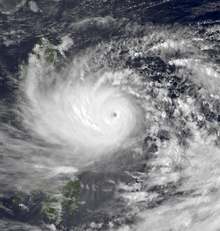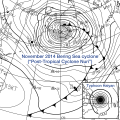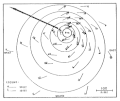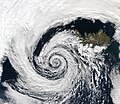Portal:Tropical cyclones
The Tropical Cyclones Portal
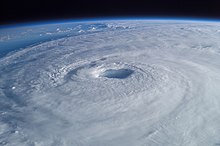
A tropical cyclone is a storm system characterized by a large low-pressure center, a closed low-level circulation and a spiral arrangement of numerous thunderstorms that produce strong winds and heavy rainfall. Tropical cyclones feed on the heat released when moist air rises, resulting in condensation of water vapor contained in the moist air. They are fueled by a different heat mechanism than other cyclonic windstorms such as Nor'easters, European windstorms and polar lows, leading to their classification as "warm core" storm systems. Most tropical cyclones originate in the doldrums, approximately ten degrees from the Equator.
The term "tropical" refers to both the geographic origin of these systems, which form almost exclusively in tropical regions of the globe, as well as to their formation in maritime tropical air masses. The term "cyclone" refers to such storms' cyclonic nature, with anticlockwise rotation in the Northern Hemisphere and clockwise rotation in the Southern Hemisphere. Depending on its location and intensity, a tropical cyclone may be referred to by names such as "hurricane", "typhoon", "tropical storm", "cyclonic storm", "tropical depression" or simply "cyclone".
Types of cyclone: 1. A "Typhoon" is a tropical cyclone located in the North-west Pacific Ocean which has the most cyclonic activity and storms occur year-round. 2. A "Hurricane" is also a tropical cyclone located at the North Atlantic Ocean or North-east Pacific Ocean which have an average storm activity and storms typically form between May 15 and November 30. 3. A "Cyclone" is a tropical cyclone that occurs in the South Pacific and Indian Oceans.
Selected named cyclone -
Typhoon Dot, known in the Philippines as Typhoon Saling, was the strongest storm of the 1985 season. Dot originated from a small area of thunderstorm activity in early to mid October. The system was first classified on October 11, and steadily intensified over the next few days. Dot attained typhoon strength on October 15, and subsequently entered a period of explosive deepening, which was not anticipated by forecasters. The next day the intensification rate slowed, but that evening, Dot attained its maximum intensify. A steady weakening trend began on October 17, though the system maintained typhoon intensity through the passage of the Philippines. After entering the South China Sea late on October 18, Dot briefly re-intensified, only to weaken as it approached Vietnam. On October 21, Dot struck Vietnam while still a typhoon, but dissipated the next day over the high terrain of the nation.
Although damage across the Philippines was less than initially expected, the typhoon lashed the nation with heavy rains. Province of Nueva Ecija suffered the worst effects from Dot. There, 500,000 acres (200,000 ha) of crops and 90% of all buildings were damaged. In Cabanatuan, 2,500 homes and 90% of structures were destroyed. Overall, 42 towns were flooded, forcing a total of 125,000 people to flee their homes, 35,000 of which were homeless. Furthermore, 52,933 houses were leveled while an additional 200,450 were damaged. Nationwide, 24 were hurt. While tracking through the South China Sea, Dot passed through Hainan Island. There, two casualties occurred while 34 others suffered injuries. Across the island, over 2,300 dwellings were destroyed. In all, Dot was responsible for 90 deaths and $104.9 million (1985 USD) in damage. (Full article...)
Selected article -
The 1970 Bhola cyclone (also known as the Great Cyclone of 1970) was a devastating tropical cyclone that struck East Pakistan (present-day Bangladesh) and India's West Bengal on 12 November 1970. It remains the deadliest tropical cyclone ever recorded and one of the world's deadliest humanitarian disasters. At least 300,000 people died in the storm, possibly as many as 500,000, primarily as a result of the storm surge that flooded much of the low-lying islands of the Ganges Delta. Bhola was the sixth and strongest cyclonic storm of the 1970 North Indian Ocean cyclone season.
The cyclone formed over the central Bay of Bengal on 8 November and traveled northward, intensifying as it did so. It reached its peak with winds of 185 km/h (115 mph) on 10 November, and made landfall on the coast of East Pakistan on the following afternoon. The storm surge devastated many of the offshore islands, wiping out villages and destroying crops throughout the region. In the most severely affected upazila Tazumuddin, over 45% of the population of 167,000 were killed by the storm. (Full article...)
Selected image -
Selected season -

The 1988 Atlantic hurricane season was a near average season that proved costly and deadly, with 15 tropical cyclones directly affecting land. The season officially began on June 1, 1988, and lasted until November 30, 1988, although activity began on May 30 when a tropical depression developed in the Caribbean. The June through November dates conventionally delimit the period of each year when most tropical cyclones form in the Atlantic basin. The first cyclone to attain tropical storm status was Alberto on August 8, nearly a month later than usual. The final storm of the year, Tropical Storm Keith, became extratropical on November 24. The season produced 19 tropical depressions of which 12 attained tropical storm status. One tropical storm was operationally classified as a tropical depression but was reclassified in post-analysis. Five tropical cyclones reached hurricane status of which three became major hurricanes reaching Category 3 on the Saffir–Simpson scale. It was later surpassed 34 years later until the 2022 Atlantic hurricane season, to have Atlantic-Pacific crossover.
There were two notable cyclones of the season, the first one being Hurricane Gilbert, which at the time was the strongest Atlantic hurricane on record. The hurricane tracked through the Caribbean Sea and the Gulf of Mexico and caused devastation in Mexico and many island nations, particularly Jamaica. Its passage caused $2.98 billion in damage (1988 USD) and more than 300 deaths, mostly in Mexico. The second one was Hurricane Joan, which struck Nicaragua as a Category 4 hurricane and caused about US$1.87 billion in damage and more than 200 deaths. The hurricane crossed into the eastern Pacific Ocean and was reclassified as Tropical Storm Miriam. Hurricane Debby also successfully crossed over, becoming Tropical Depression Seventeen-E, making the 1988 season the first on record in which more than one tropical cyclone has crossed between the Atlantic and Pacific basins intact. (Full article...)
Related portals
Currently active tropical cyclones

Italicized basins are unofficial.
- North Atlantic (2024)
- No active systems
- East and Central Pacific (2024)
- No active systems
- West Pacific (2024)
- Typhoon Yinxing (Marce)
- Severe Tropical Storm Toraji (Nika)
- Tropical Storm Man-yi
- North Indian Ocean (2024)
- No active systems
- Mediterranean (2024–25)
- No active systems
- South-West Indian Ocean (2024–25)
- No active systems
- Australian region (2024–25)
- No active systems
- South Pacific (2024–25)
- No active systems
- South Atlantic (2024–25)
- No active systems
Last updated: 02:37, 11 November 2024 (UTC)
Tropical cyclone anniversaries

November 12
- 1970 - The 1970 Bhola cyclone (pictured) made landfall on the densely populated Ganges Delta in East Pakistan (now Bangladesh) killing up to 500,000 people and becoming the deadliest tropical cyclone in recorded history.
- 2002 - The 2002 West Bengal cyclone made landfall over in West Bengal, killing 173 people in total.

November 13
- 1900 - The strongest typhoon on record to strike Guam killed about 100 people on the island.
- 1977 - Typhoon Kim made landfall in the Philippines with 210 km/h (130 mph) winds. Flash flooding killed over 55 people and caused severe damage.
- 1984 - A cyclone (pictured) makes landfall over in India, killing 430 people in total.
- 1998 - Tropical Storm Chip affects Vietnam killing 17 people and causing 16.2 billion₫ (US$1 million) of damages.

- November 14, 1990 - Typhoon Mike (pictured) reintensified in the South China Sea after killing over 250 people in the Philippines.
Did you know…
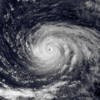



- …that the Joint Typhoon Warning Center considers that Typhoon Vera (pictured) of 1986 is actually two distinct systems, formed from two separated low-level circulations?
- …that Cyclone Freddy (track pictured) in 2023 was the longest-lasting tropical cyclone worldwide?
- …that Cyclone Raquel (track pictured) travelled between the Australian and South Pacific basins between the 2014–15 and 2015–16 seasons, spanning both seasons in both basins?
- …that Hurricane Otis (pictured) in 2023 was the first Pacific hurricane to make landfall at Category 5 intensity and surpassed Hurricane Patricia as the strongest landfalling Pacific hurricane on record?
General images -

From 1975 to 1999, 83 Atlantic hurricanes have affected the U.S. state of Florida. Collectively, tropical cyclones in Florida during the time period resulted in at least $45 billion (2008 USD) in damage, primarily from Hurricane Andrew. Additionally, tropical cyclones in Florida were directly responsible for 54 fatalities during the period. Several tropical cyclones produced over 20 inches (510 mm) of rainfall in the state, including Hurricane Georges which is the highest total during the time period. The 1985 season was the year with the most tropical cyclones affecting the state, with a total of eight systems. Every year included at least one tropical cyclone affecting the state.
The strongest hurricane to hit the state during the time period was Hurricane Andrew, which was one of only four Category 5 hurricanes to strike the United States. Andrew, at the time, was the costliest tropical cyclone in United States history. Additionally, Hurricane Eloise and Hurricane Opal hit the state as major hurricanes.
(Full article...)Topics
Subcategories
Related WikiProjects
WikiProject Tropical cyclones is the central point of coordination for Wikipedia's coverage of tropical cyclones. Feel free to help!
WikiProject Weather is the main center point of coordination for Wikipedia's coverage of meteorology in general, and the parent project of WikiProject Tropical cyclones. Three other branches of WikiProject Weather in particular share significant overlaps with WikiProject Tropical cyclones:
- The Non-tropical storms task force coordinates most of Wikipedia's coverage on extratropical cyclones, which tropical cyclones often transition into near the end of their lifespan.
- The Floods task force takes on the scope of flooding events all over the world, with rainfall from tropical cyclones a significant factor in many of them.
- WikiProject Severe weather documents the effects of extreme weather such as tornadoes, which landfalling tropical cyclones can produce.
Things you can do
 |
Here are some tasks awaiting attention:
|
Wikimedia
The following Wikimedia Foundation sister projects provide more on this subject:
-
Commons
Free media repository -
Wikibooks
Free textbooks and manuals -
Wikidata
Free knowledge base -
Wikinews
Free-content news -
Wikiquote
Collection of quotations -
Wikisource
Free-content library -
Wikiversity
Free learning tools -
Wikivoyage
Free travel guide -
Wiktionary
Dictionary and thesaurus

